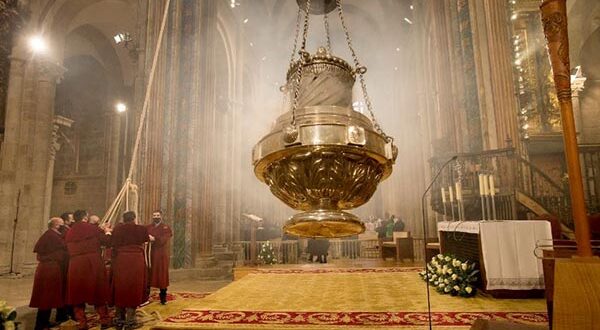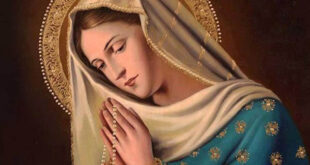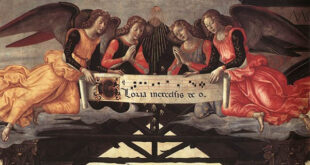In the heart of the majestic Cathedral of Santiago de Compostela, where ancient stone seems to whisper prayers and stained-glass windows filter divine light, there stands a unique symbol that transcends time and space: the Botafumeiro. This giant thurible, which swings majestically above the heads of pilgrims and faithful, is not just an impressive liturgical object but a bridge between heaven and earth, a tangible reminder of God’s presence among His people. In this article, we will explore its history, its theological significance, and its relevance in today’s world, inviting you to discover how this ancient ritual can inspire and elevate your spiritual life.
The Botafumeiro: History and Tradition
The Botafumeiro, whose name comes from Galician and means “smoke thrower,” is one of the largest thuribles in the world, weighing approximately 53 kilograms and standing 1.60 meters tall. Its use dates back to the 11th century, when pilgrims began arriving in Santiago de Compostela after the discovery of the remains of the Apostle James. At that time, the Botafumeiro not only served a liturgical purpose but also a practical one: the incense helped purify the air in a cathedral filled with weary pilgrims, many of whom had been traveling for days or even months.
However, its significance goes beyond the practical. Incense has been, since biblical times, a symbol of prayer and worship. In Psalm 141, we read: “May my prayer be set before you like incense.” The smoke rising toward heaven represents the supplications of the faithful seeking to draw closer to God. In this sense, the Botafumeiro not only purifies the air but also elevates souls toward the divine.
The Ritual: A Spectacle of Faith and Coordination
Watching the Botafumeiro in action is a breathtaking experience. Eight men, known as tiraboleiros, pull on a thick rope to make it swing in an arc of over 20 meters, reaching speeds of up to 68 kilometers per hour. The sound of the rope scraping against the stone, the smell of incense, and the hypnotic movement of the Botafumeiro create an atmosphere that invites contemplation and awe.
This ritual is not just a spectacle but a metaphor for the spiritual life. The Botafumeiro, with its pendulum-like motion, reminds us that faith is not static but dynamic. We oscillate between doubt and certainty, between sin and grace, but we are always called to return to God. Moreover, the coordination required to operate the Botafumeiro reflects the importance of community in Christian life. Just as the tiraboleiros work together to achieve harmonious movement, we are called to support one another on our path to holiness.
The Theological Meaning: Incense, Prayer, and Divine Presence
In Catholic tradition, incense carries profound theological significance. In the Old Testament, God commanded Moses to use incense in the Tabernacle (Exodus 30:34-38). This act was not merely ceremonial; it symbolized God’s presence among His people. In the New Testament, the Magi offered incense to Jesus as an acknowledgment of His divinity (Matthew 2:11). Thus, incense connects us with the history of salvation and reminds us that God is present in our midst.
The Botafumeiro, with its smoke filling the cathedral, invites us to reflect on the omnipresence of God. In a world full of distractions and noise, this ritual calls us to pause, to lift our minds and hearts toward the eternal. It is an invitation to prayer, worship, and contemplation of the sacred.
The Botafumeiro in Today’s Context: A Message for the Modern World
In our digital age, where immediacy and the ephemeral seem to dominate our lives, the Botafumeiro offers a powerful counterpoint. Its slow and deliberate movement reminds us of the importance of patience and perseverance in the spiritual life. Just as the incense takes time to fill the cathedral, our relationship with God requires time, dedication, and constancy.
Furthermore, in a world marked by division and individualism, the Botafumeiro speaks of unity and community. The pilgrims who arrive in Santiago de Compostela come from different cultures, languages, and realities, but they all unite in a common purpose: to seek God. The Botafumeiro, with its smoke enveloping everyone equally, reminds us that before God, we are all equal, children of the same Father.
Conclusion: Let the Botafumeiro Elevate Your Soul
The Botafumeiro is not just a relic of the past but a living symbol of the Catholic faith. Its history, its ritual, and its theological meaning invite us to deepen our relationship with God and with others. In a world that often seems to drift away from the sacred, this giant thurible calls us back to what is essential: prayer, worship, and the pursuit of God.
The next time you see the Botafumeiro in action, whether in person or through a screen, let its movement inspire you. Let its smoke lift your prayers and its presence remind you that God is always near, ready to welcome you with love and mercy. As pilgrims on this earth, we are called to keep moving forward, with the certainty that, at the end of the journey, the eternal light of Christ awaits us.
May the Botafumeiro be for you not just a spectacle but a call to holiness, a reminder that, amid the oscillations of life, God is always with you, guiding you toward His infinite love.






